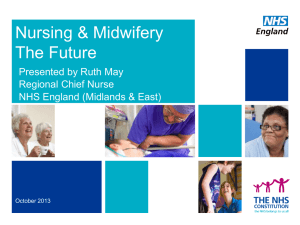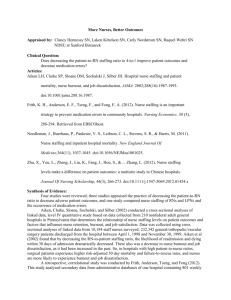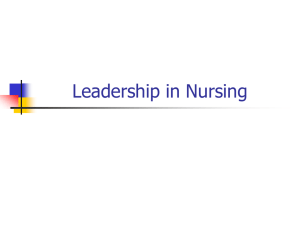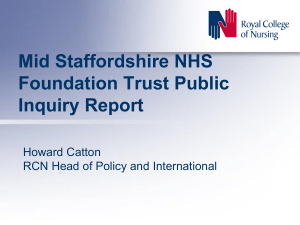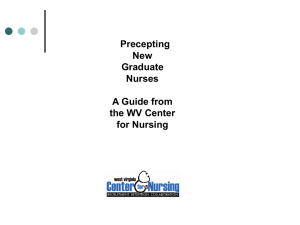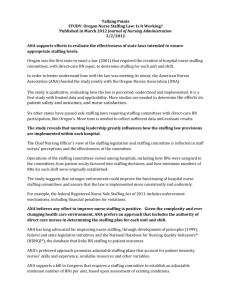Skill Mix - SLAM - Mental Health & Learning Disability Nurse
advertisement
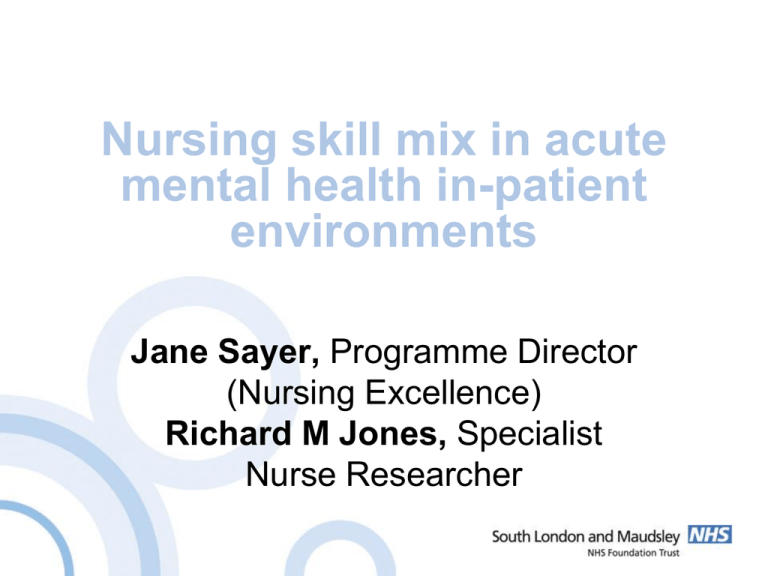
Nursing skill mix in acute mental health in-patient environments Jane Sayer, Programme Director (Nursing Excellence) Richard M Jones, Specialist Nurse Researcher Why is skill mix important? • Current financial climate • 1 in 10 patients report that there were rarely or never enough nurses available on in-patient units (CQC, 2010) • Positive effect on outcome supported by evidence MHMDS report on 2010 • 5.1% increase in use of inpatient facilities (8.5% of total MH users) • 30.1% rise in number of people detained under MHA (lower level of 17.5% possible) • Number of voluntary patients falling for 4 years • Number of women detained via courts or prison saw an 85% rise last year NHS mental hospitals are increasingly being used to care for and contain people who pose a risk to themselves or others (MHMDS, 2010, Bowers & Flood 2008) The effect on outcomes • • • • 26% higher mortality in hospitals with poorer nursing levels Higher burnout rates Twice as likely to be dissatisfied in their job More likely to report low/ deteriorating quality of care on their wards Rafferty 2007 • MH environments: higher staffing levels = lower re-admission rates. Substantially better outcomes achieved when attention patients received from staff was taken into account Coleman & Paul 2001 • 9% of suicides could have been prevented by increasing staff numbers and 6% by increasing beds and services Appleby et al 2006 The cost of in-patient care • Fivefold cost variance between UK MH trusts (£4.3 to £24.6 million) Associations between nursing cost per bed and performance indicators were found Bowers & Flood 2008 • Conflict and containment in in-patient mental health settings in England estimated at £178.5 million per year Flood et al 2008 ‘whilst low registered nurse staffing levels should be considered a risk factor for poor quality care, increasing nurse staffing may not be a sufficient solution’ NNRU (2009) Addressing grades RN- LPN- HCA- NA • Higher levels of RN= lower rates of adverse outcomes Needleman el at (2002) • Higher RN levels = less likely to die in hospital. Higher levels of LPN more likely to die Person et al (2004) • Violence associated with discrepancy between acuity and available staff • Higher skill mix and BSc qualified nurses associated with fewer incidents of violence Roche et al (2010) • Higher LPN investment = more pressure ulcers, and wage saving more than offset by additional treatment costs Hendrix and Foreman (2001) • Mental health environments in the UK are mostly staffed by the most junior, least qualified workforce, yet they care for the most acutely (and increasingly so) unwell patients Needleman (2006) 3 options 1. Increase proportion of RN hours but not total nursing hours 2. Increase total number of hours of RNS and LPNs without changing proportion 3. Increase proportion of RN hours and total number of nursing hours of both groups References. Appleby, L. Shaw, J. and Kapur, N. (2006) Avoidable deaths: five year report of the national confidential inquiry into suicide and homicide by people with mental illness. University of Manchester. Bowers, l. and Flood, C. (2008) Nurse staffing, bed numbers and the cost of acute psychiatric care in England. Journal of Psychiatric and mental health nursing. 15 630-637. Coleman, J.C and Paul, G.L (2001) Relationship between staffing ratios and effectiveness of inpatient units. Psychiatric Services. 52, 1374-1379. CQC (2010) Supporting briefing note: issues highlighted by the 2009 survey of patients in NHS hospitals in England. Flood, C. Bowers, L. Parkin, D. (2008) Estimating the costs of conflict and containment on adult inpatient psychiatric wards. Nursing Economics. 26, (5). Hendrix, t. and Foreman, s. (2001) Optimal long term care nurse staffing levels. Nursing economics. 19 (4) 164-175. MHMDS (2010) the information centre for health and social care. In-patients formally detained in hospital under the MHA 1983 and patients subject to SCT. Annual figure. England 09/10- October 2010. Needleman, J. et al (2002). Nurse staffing levels and the quality of care in hospitals. New England Journal of medicine. 346 (22) 1715-1722. Needleman, J. (2006) Nurse staffing in hospital: is there a business case for quality? Health affairs. 25 (1) 204-211. Person, S. et al (2004). Nurse staffing and mortality for medicare patients with acute myocardial infarction. Medical care 42 (1) 4-12. Policy+ (2009) Is there a case for the UK nursing workforce to include grades of qualified nurse other than the registered nurse? (21) October. Rafferty, AM. Et al (2007) Outcomes of variation in hospital nurse staffing in English hospitals: cross sectional analysis of survey data and discharge records. Int. Journal of Nursing studies, 44 (2) 175-182. Roche et al (2010) Violence toward nurses, the work environment, and patient outcomes. The Journal of Nursing Scholarship. 42 (1) 13-22 Average staffing and patient data- NHS wards by speciality (all shifts), (RCN 2009) Mental health Adult Paediatric Older adults All No. of beds 19 26 20 27 24 Total No. of patients 17 25 15 25 23 Occupancy (%) 88 99 80 95 95 No. of RNs 2.1 3.1 3.6 2.5 3.1 Number of HCAs 2.1 2.0 .8 2.7 2.0 Total staff on duty (RN+HCA) 4.3 5.1 4.3 5.2 4.9 RNs as a % of total staff 50 62 83 48 61 Mean across all RNs 9.2 9.1 4.6 11.3 8.7 Patients per member of nursing staff (mean across total) 4.1 5.4 3.8 5.2 4.9 No of cases. 76 451 124 103 1011 Patients per registered nurse


